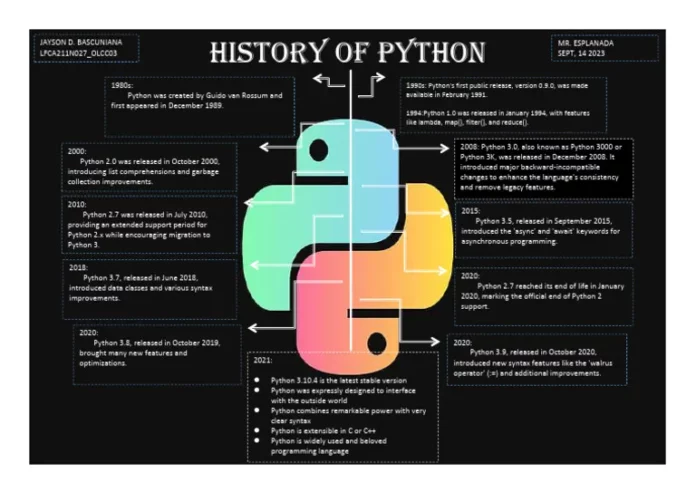Python: History and Versions
Python began in the late 1980s, and Guido Van Rossum started its implementation in December 1989 at CWI in the Netherlands. By February 1991, he published the initial code (version 0.9.0) to alt.sources. Python 1.0 was released in 1994, introducing features like lambda functions, map, filter, and reduce. Subsequent versions, like Python 2.0 in 2000 and Python 3.0 (Py3K) in 2008, brought significant improvements and changes.
The name “Python” was inspired by the BBC comedy series “Monty Python’s Flying Circus,” chosen for its uniqueness and a touch of mystery. Python’s versatility has made it essential in fields like Machine Learning, Artificial Intelligence, Web Development, Mobile and Desktop Applications, Scientific Computing, and more.
Python Version List
Here are some key Python versions and their release dates:
- Python 1.0 – January 1994
- Python 2.0 – October 16, 2000
- Python 3.0 – December 3, 2008
- Python 3.8 – October 14, 2019
Tips for Learning Python
- Clarify Your Goals: Understand why you want to learn Python, whether it’s for data analysis, AI, games, or other applications.
- Master Basic Syntax: Python’s syntax is simple and similar to English, making it easy to learn. Focus on Python 3, as Python 2.7 is outdated.
- Practice Coding: Write code regularly, starting with simple projects like a calculator or a to-do list. This hands-on practice builds understanding.
- Take Notes: Create concise notes with examples. Studies show that writing notes helps in learning and retention.
- Engage with Others: Discuss Python concepts with peers or online communities. Teaching others also reinforces your own knowledge.
- Explore Libraries: Python offers numerous libraries and frameworks like TensorFlow for AI, Django and Flask for web development, and Pandas for data analysis.
- Contribute to Open Source: Participate in open-source projects to gain practical experience and receive feedback from the community.
Python’s Versatility
Python’s popularity stems from its user-friendly nature and wide applicability:
- Desktop Applications
- Web Development
- Data Science and AI
- Machine Learning
- Scientific Computing
- Robotics and IoT
- Gaming and Mobile Apps
- Data Analysis and Preprocessing
In the next section, we’ll explore Python’s applications in more detail.


